© 2010-2023 by Fine Arts of the Southwest, Inc. All rights reserved.
Unauthorized reproduction or use is strictly prohibited by law.
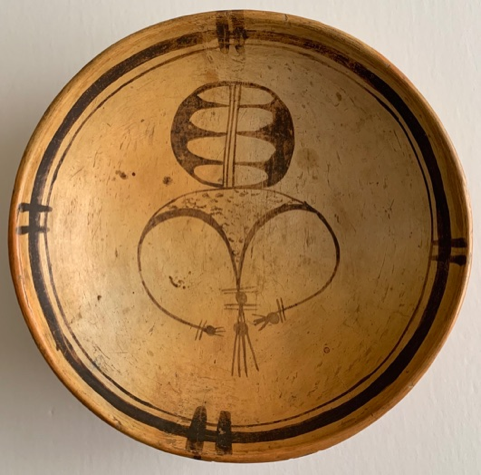
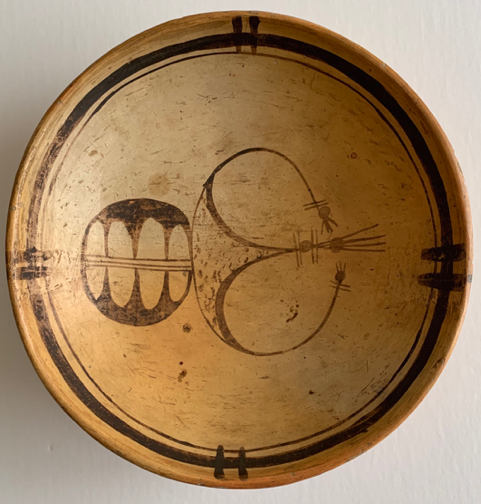
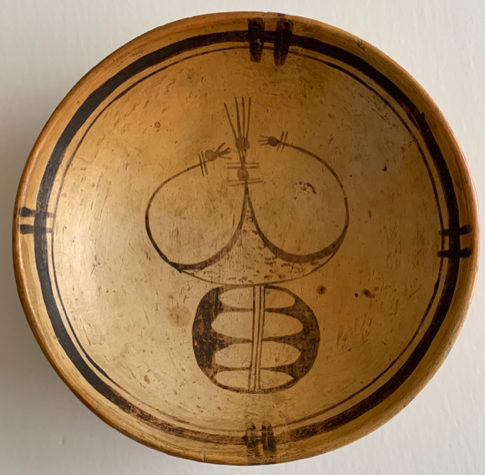
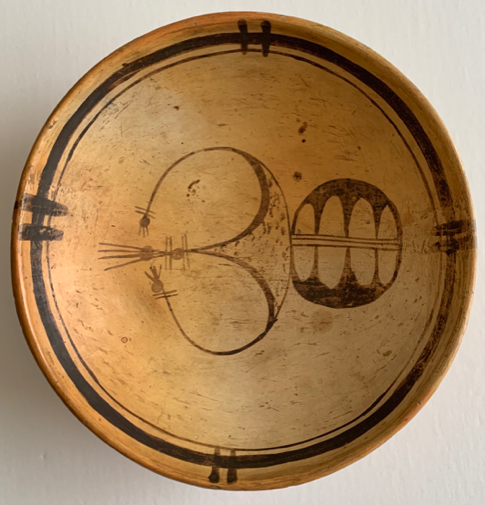
A striking Hopi black-on-yellow pottery
bowl by Nampeyo of Hano, c.1900
DECADES BEFORE GEORGIA O’KEEFFE ever set a foot in the American Southwest there was the great American Modernist painter and Hopi pottery-maker, Nampeyo of Hano (1856-1942). Nampeyo was no coddled, privileged, academic art world darling; she never once entered an art school or studio, she didn’t paint on French linen canvases stretched by paid assistants or purchase Winsor and Newton English oil paints or attend prestigious art schools, gallery openings, cocktail parties, society dinners and museum exhibitions or consort with the rich and famous of the art, society and financial worlds.
What Nampeyo did was make fabulous art pure and simple; she made pottery virtually every day in the most unimaginably difficult of conditions. She sat on a blanket on the hard, stony ground outside her small stone house on the top of a dusty remote windblown mesa in the middle of nowhere northern Arizona in the heat and howling wind and dust and burning sunlight and rain and sleet and snow and ice and made pottery all day long. She also made pottery in the evenings and at night sitting on the dirt floor or low bancos of her humble dwelling. It’s a different form of artistic dedication and devotion you might say than most of our formally educated and comfortably-cocooned European and American artists no matter how much talent they might have had. Georgia O’Keefe was an extremely capable and accomplished artist indeed, but she would have quickly and literally run kicking and screaming from the grueling reality of Nampeyo’s daily creative circumstances.
“Nampeyo’s fame as a potter has soared over the past 50 years, and the excellence
of this vessel’s shaping and painting attests to why. She was a unique personality,
with an insatiable artistic hunger that pushed her to constant experimentation
with new compositions and vessel forms.”
-Edwin L. Wade, Ph.D.
This lovely bowl has a unique and very striking Modernist abstract painted design which could possibly be a stylized interpretation of a flower or bud of some kind. The design has a wonderful, airy and spatial quality and is defined as much by the beautiful negative space Nampeyo skillfully incorporated as by the painted areas themselves. The design is rendered in black paint only against the creamy, rich, whitish-yellow color of the clay body. In addition to the superb aesthetics in evidence here, the technical quality of the pottery vessel is noteworthy as always with Nampeyo’s work, the vessel walls are very beautifully formed: thin and even and the stone polishing is nothing less than remarkable; the long even parallel strokes of the polishing stone that are visible on the plain bottom surface of the bowl are literally a beautiful work of art in themselves.
Finally, after forming, painting and polishing the bowl, Nampeyo perfectly coal-fired it; firing pottery with very high-temperature burning Lignite coal is an exacting, unforgiving, very treacherous process which when properly accomplished yields the porcelain hard surface and the incredibly beautiful, creamy whitish-yellow surface color and lovely firing blushes. The bowl measures 8 1/4” in diameter and is 2” in height. It is in very fine original condition for its 120-or-so years of age. There is a very slight surface slip crack extending about two inches in from the rim which does not go through the clay body, there are also a few surface stains and various slight surface slip cracking here and there and there are a few very minor chips around the exterior rim. The black painted design is somewhat faded as black paint on older Hopi pottery vessels often is due to its fugitive nature but the design is still strong and vibrant.
This is a superb and beautiful pottery bowl by an extraordinary woman who was a brilliant traditional Hopi potter and a ground-breaking Modern American artist at the same time although she may not have been aware of this; it’s an amazing and unprecedented artistic and aesthetic synthesis which makes Nampeyo one of the greatest American artists of her own or of any other time.
Price $6,950
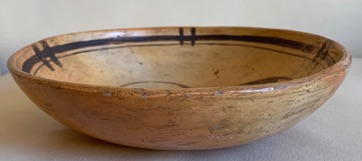
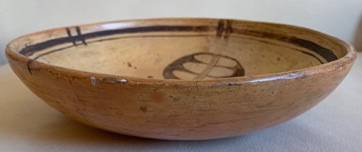
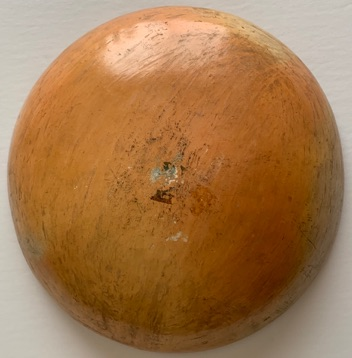
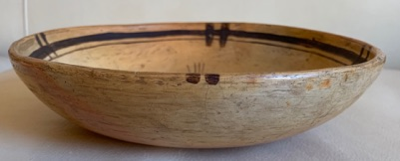
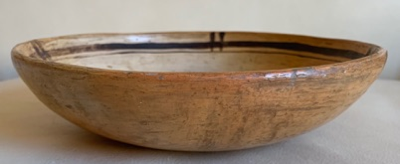
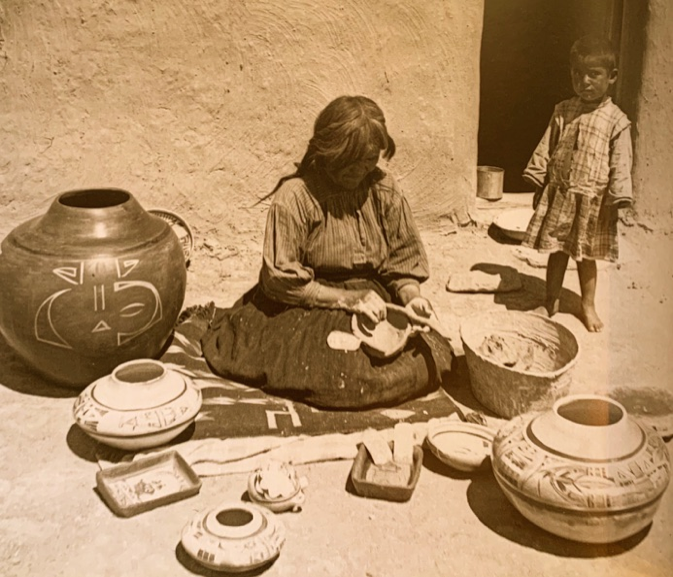
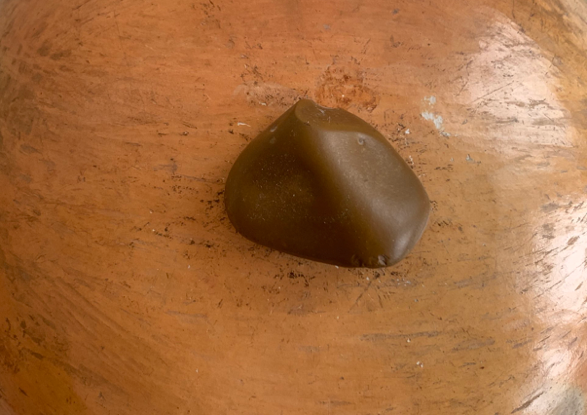
“Mrs. Nampeyo, an acknowledged best Hopi Indian woman Pottery maker,
1st Mesa, Hopiland, Ariz. Sichomovi” by R. Raffius, 1905.
Photo source and © Keystone-Mast Collection, UCR/California Museum of Photography, University of California, Riverside
The remarkable stone-polishing on this bowl was accomplished possibly using this very polishing stone or another one like it. When she was a young woman, Nampeyo found this centuries-old polishing stone in the ruins of the ancient Hopi pottery-making village of Sikyatki and after using it to polish her own pottery for many years she gave it as a special gift before her death in 1942 to her then-teenaged Great-Granddaughter, the now-also renowned Hopi potter, Dextra Quotskuyva Nampeyo (1928-2019). Dextra also used it on her pottery and many years later gifted it to her special close friend and ours, the late Santa Fe Native American Arts dealer, Martha Hopkins Struever (1931-2017) , who subsequently gave the stone to us.
